Doris Duranti (1917-1995) was a beautiful star of the Italian cinema of the late 1930s and early 1940s and the main competitor of actress Clara Calamai. She was also the lover of a notorious fascist. Duranti appeared in 43 films between 1935 and 1975.
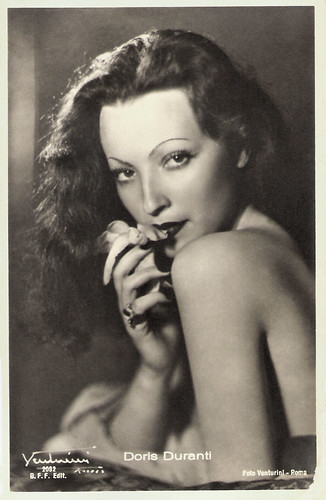
Italian postcard by B.F.F. Edit. (Ballerini & Fratini Firenze), no. 2092. Photo: Venturini, Roma.
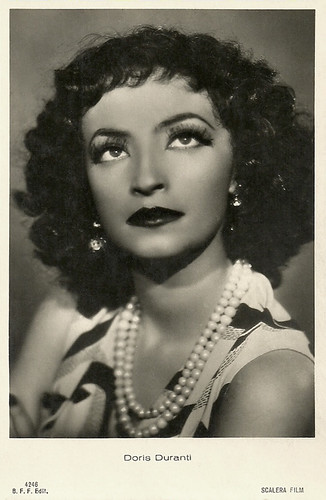
Italian postcard by B.F.F. Edit. (Ballerini & Fratini Firenze), no. 4246. Photo: Scalera Film.

Italian postcard by Rizzoli & C. , Milano, 1940. Photo: Venturini.
Dora Franca Duranti was born in Livorno (Leghorn), Italy, in 1917.
From 1935 on, so at a young age, she started her film career as an extra or in minor parts in films like Aldebaran (Alessandro Blasetti, 1935) starring Gino Cervi, the Tito Schipa vehicle Vivere/To Live (Guido Brignone, 1937) and La gondola delle chimere/The Phantom Gondola (Augusto Genina, 1936) with Fosco Giachetti. She collaborated again with Genina and Giachetti in Lo squadrone bianco/White Squadron (Augusto Genina, 1936), shot in Libya.
Essential for her career was the film agent Eugenio Fontana, who for years arranged her deals with directors and producers. In Sentinelle di bronzo/Sentinels of Bronze (Romolo Marcellini, 1937) Duranti obtained her first real success as the protagonist, a coloured woman. From that moment on she became a film star, famous for her elegant movements but also her aggressive behaviour. Between Sentinelle di bronzo and 1945, Duranti made some 17 films.
Among her major performances were Lola in Cavalleria rusticana (Amleto Palermi, 1939) adapted from the famous opera by Mascagni, and the title roles in La contessa Castiglione/The Countess of Castiglione (Flavio Calzavara, 1942) and Carmela (Flavio Calzavara, 1942).
In the latter, Duranti showed a naked breast, which gave life to a famous quarrel between Duranti and her rival star Clara Calamai who also flashed one breast in the period piece La cena delle beffe/The Jester's Supper (Alessandro Blasetti, 1941). Duranti, however, claimed she was the first to show her breast standing up, proud and without make-up, in contrast to Calamai who showed while lying down. Anyway, neither of the two was first, as Vittoria Carpi had already flashed a breast in the fantasy film La corona di ferro/The Iron Crown (Alessandro Blasetti, 1940).
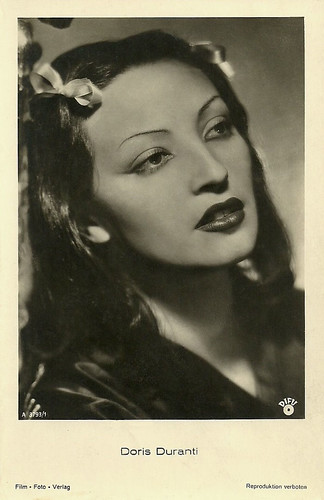
German postcard by Film-Foto-Verlag, no. A 3793/1, 1941-1944. Photo: DIFU.

German postcard by Film-Foto-Verlag, no. G 208, 1941-1944. Photo: DIFU.
Doris Duranti had become one the best-paid and highest esteemed actresses of the fascist regime, but, unwisely, she also started an affair with Alessandro Pavolini.
In 1938, this notorious fascist had become Minister of Popular Culture in the government of Repubblica Sociale Italiana led by Benito Mussolini. Pavolini for instance rejected the neorealist scripts by Luchino Visconti, Giuseppe De Santis and others.
Duranti became known as ‘the actress par excellence/for His Excellence’. Mussolini first opposed, then accepted the affair. He seems to have been smitten with Duranti’s performance in Il re si diverte/The King's Jester (Mario Bonnard, 1941), an adaptation of the opera 'Rigoletto', with Michel Simon as Rigoletto and Duranti as Margot.
When the fascist regime fell in 1943, Duranti followed her lover Pavolini to the North, where they first lived in Venice, where the so-called Repubblica Sociale Italiana thought of reviving Rome’s Cinecittà.
After that they moved to Lake Como, Pavolini was one of the main leaders in mobilising the fascists against the Allies. He was responsible for a brutal massacre in Ferrara in November 1943, revenging the killing of a high official (it was never revealed whether partisans really had been responsible). Pavolini also had a major part in the execution in January 1944 of the members of the Grand Council who had Mussolini arrested in July 1943. Among them was Mussolini’s son-in-law Galeazzo Ciano.
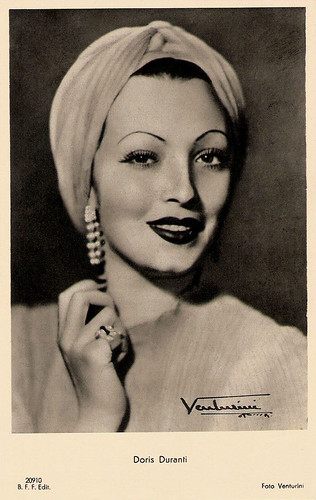
Italian postcard by B.F.F. Edit. (Casa Editore Ballerini & Fratini, Firenze), no. 20910. Photo: Venturini.
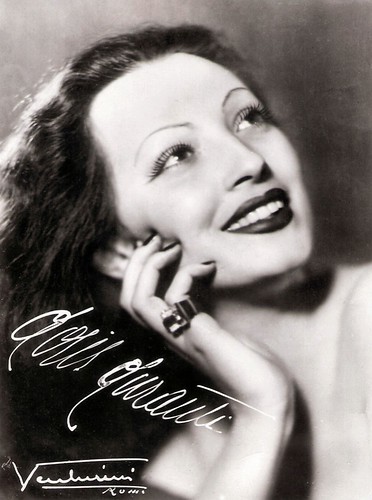
Italian postcard by Armando Terzoli, Roma. Photo: Venturini, Roma.
When things went bad for the fascist Republic and the Allies were heading north, Pavolini managed to get Doris Duranti a passage to Switzerland and she moved to Lugano. Here she was imprisoned and she tried to kill herself by opening her veins.
Pavolini was captured in April 1945 by the Partisans, shot and hung in public in Milan next to the corpse of Mussolini. Duranti later on married a police lieutenant and moved with him to South America, where she remained for many years.
In 1950 Duranti returned to Italy, where audiences apparently had forgiven her her past. She played in several Italian films and even had quite a few leads in films like the comedy Il voto/The Vote (Mario Bonnard, 1950), the crime drama I falsari/The Counterfeiters (Franco Rossi, 1950) with Fosco Giachetti, and the romantic war drama Clandestino a Trieste/Fugitive in Trieste (Guido Salvini, 1951).
All in all, she played in some 14 films between 1950 and 1954, including one French film, La minute de vérité'/The Moment of Truth (Jean Delannoy, 1952). She then met the famous journalist and radio reporter Mario Ferretti, the two fell in love and they moved to Santo Domingo in the Dominican Republic, where they opened up a restaurant.
Duranti’s last performance was in the film Divina creatura/The Divine Nymph (Patroni Griffi, 1976) starring Laura Antonelli. In 1995 Doris Duranti died in Santo Domingo at the age of 78 years. Her life has been the subject of the TV series Doris, una diva di regime (Alfredo Giannetti, 1991) with Elide Melli playing Duranti.

Italian postcard by Ed. Vecchioni e Guadagno Roma, for Cinema Teatro Impero, Siena. Photo: Mediterranea Film. Antonio Centa and Doris Duranti in the Italian colonial propaganda film Sotto la croce del sud/Under the Southern Cross (Guido Brignone, 1938), partly shot in Ethiopia.

Italian postcard by Zincografica, Firenze. Photo: Produzione Incine / Scalera Film. Doris Duranti and Claudio Gora in Resurezzione/Resurrection (Flavio Calzavara, 1944), based on Leo Tolstoy's classic novel 'Resurrection' (1899), often adapted to film.
A little homage to Duranti. Source: Marco Sisi (YouTube).
Sources: Wikipedia (Italian and English), and IMDb.
This post was last updated on 2 January 2024.

Italian postcard by B.F.F. Edit. (Ballerini & Fratini Firenze), no. 2092. Photo: Venturini, Roma.

Italian postcard by B.F.F. Edit. (Ballerini & Fratini Firenze), no. 4246. Photo: Scalera Film.

Italian postcard by Rizzoli & C. , Milano, 1940. Photo: Venturini.
The quarrel of the first naked breast
Dora Franca Duranti was born in Livorno (Leghorn), Italy, in 1917.
From 1935 on, so at a young age, she started her film career as an extra or in minor parts in films like Aldebaran (Alessandro Blasetti, 1935) starring Gino Cervi, the Tito Schipa vehicle Vivere/To Live (Guido Brignone, 1937) and La gondola delle chimere/The Phantom Gondola (Augusto Genina, 1936) with Fosco Giachetti. She collaborated again with Genina and Giachetti in Lo squadrone bianco/White Squadron (Augusto Genina, 1936), shot in Libya.
Essential for her career was the film agent Eugenio Fontana, who for years arranged her deals with directors and producers. In Sentinelle di bronzo/Sentinels of Bronze (Romolo Marcellini, 1937) Duranti obtained her first real success as the protagonist, a coloured woman. From that moment on she became a film star, famous for her elegant movements but also her aggressive behaviour. Between Sentinelle di bronzo and 1945, Duranti made some 17 films.
Among her major performances were Lola in Cavalleria rusticana (Amleto Palermi, 1939) adapted from the famous opera by Mascagni, and the title roles in La contessa Castiglione/The Countess of Castiglione (Flavio Calzavara, 1942) and Carmela (Flavio Calzavara, 1942).
In the latter, Duranti showed a naked breast, which gave life to a famous quarrel between Duranti and her rival star Clara Calamai who also flashed one breast in the period piece La cena delle beffe/The Jester's Supper (Alessandro Blasetti, 1941). Duranti, however, claimed she was the first to show her breast standing up, proud and without make-up, in contrast to Calamai who showed while lying down. Anyway, neither of the two was first, as Vittoria Carpi had already flashed a breast in the fantasy film La corona di ferro/The Iron Crown (Alessandro Blasetti, 1940).

German postcard by Film-Foto-Verlag, no. A 3793/1, 1941-1944. Photo: DIFU.

German postcard by Film-Foto-Verlag, no. G 208, 1941-1944. Photo: DIFU.
The actress par excellence for His Excellence
Doris Duranti had become one the best-paid and highest esteemed actresses of the fascist regime, but, unwisely, she also started an affair with Alessandro Pavolini.
In 1938, this notorious fascist had become Minister of Popular Culture in the government of Repubblica Sociale Italiana led by Benito Mussolini. Pavolini for instance rejected the neorealist scripts by Luchino Visconti, Giuseppe De Santis and others.
Duranti became known as ‘the actress par excellence/for His Excellence’. Mussolini first opposed, then accepted the affair. He seems to have been smitten with Duranti’s performance in Il re si diverte/The King's Jester (Mario Bonnard, 1941), an adaptation of the opera 'Rigoletto', with Michel Simon as Rigoletto and Duranti as Margot.
When the fascist regime fell in 1943, Duranti followed her lover Pavolini to the North, where they first lived in Venice, where the so-called Repubblica Sociale Italiana thought of reviving Rome’s Cinecittà.
After that they moved to Lake Como, Pavolini was one of the main leaders in mobilising the fascists against the Allies. He was responsible for a brutal massacre in Ferrara in November 1943, revenging the killing of a high official (it was never revealed whether partisans really had been responsible). Pavolini also had a major part in the execution in January 1944 of the members of the Grand Council who had Mussolini arrested in July 1943. Among them was Mussolini’s son-in-law Galeazzo Ciano.

Italian postcard by B.F.F. Edit. (Casa Editore Ballerini & Fratini, Firenze), no. 20910. Photo: Venturini.

Italian postcard by Armando Terzoli, Roma. Photo: Venturini, Roma.
Passage to Switzerland
When things went bad for the fascist Republic and the Allies were heading north, Pavolini managed to get Doris Duranti a passage to Switzerland and she moved to Lugano. Here she was imprisoned and she tried to kill herself by opening her veins.
Pavolini was captured in April 1945 by the Partisans, shot and hung in public in Milan next to the corpse of Mussolini. Duranti later on married a police lieutenant and moved with him to South America, where she remained for many years.
In 1950 Duranti returned to Italy, where audiences apparently had forgiven her her past. She played in several Italian films and even had quite a few leads in films like the comedy Il voto/The Vote (Mario Bonnard, 1950), the crime drama I falsari/The Counterfeiters (Franco Rossi, 1950) with Fosco Giachetti, and the romantic war drama Clandestino a Trieste/Fugitive in Trieste (Guido Salvini, 1951).
All in all, she played in some 14 films between 1950 and 1954, including one French film, La minute de vérité'/The Moment of Truth (Jean Delannoy, 1952). She then met the famous journalist and radio reporter Mario Ferretti, the two fell in love and they moved to Santo Domingo in the Dominican Republic, where they opened up a restaurant.
Duranti’s last performance was in the film Divina creatura/The Divine Nymph (Patroni Griffi, 1976) starring Laura Antonelli. In 1995 Doris Duranti died in Santo Domingo at the age of 78 years. Her life has been the subject of the TV series Doris, una diva di regime (Alfredo Giannetti, 1991) with Elide Melli playing Duranti.

Italian postcard by Ed. Vecchioni e Guadagno Roma, for Cinema Teatro Impero, Siena. Photo: Mediterranea Film. Antonio Centa and Doris Duranti in the Italian colonial propaganda film Sotto la croce del sud/Under the Southern Cross (Guido Brignone, 1938), partly shot in Ethiopia.

Italian postcard by Zincografica, Firenze. Photo: Produzione Incine / Scalera Film. Doris Duranti and Claudio Gora in Resurezzione/Resurrection (Flavio Calzavara, 1944), based on Leo Tolstoy's classic novel 'Resurrection' (1899), often adapted to film.
A little homage to Duranti. Source: Marco Sisi (YouTube).
Sources: Wikipedia (Italian and English), and IMDb.
This post was last updated on 2 January 2024.
No comments:
Post a Comment